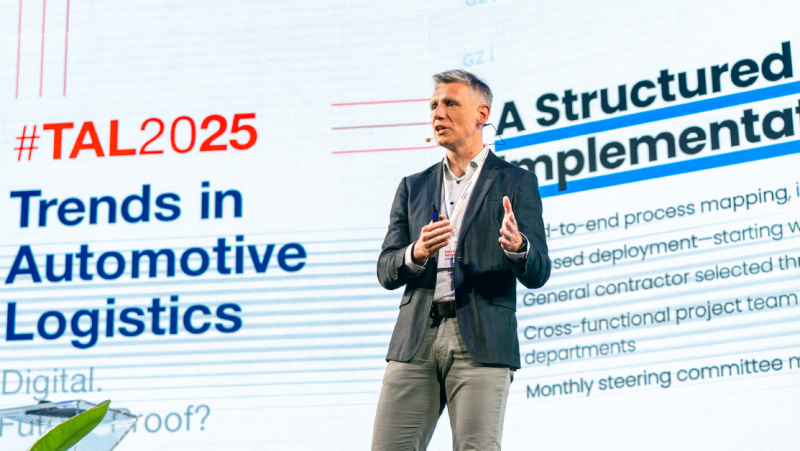Automation Remains Main Trend in Czech Logistics Even in Times of Expected Crisis
- Trends
- Article
What does the present and future of Czech logistics look like? Where are investments going? To what extent is the storage and logistics sector affected by the post-COVID situation and the war in Ukraine? These and other questions were answered in the unique Trends in Czech Logistics 2022 survey conducted by Ipsos for the SKLAD trade association, of which Aimtec is a member. 132 companies took part in the survey and the responses by their managers show an emphasis on deepening digitalization and optimization of logistics processes and warehousing.
Localisation and Savings
The current situation on the Czech logistics market is influenced by a combination of the impact of the covid-19 pandemic and the war conflict in Ukraine. These negative circumstances are particularly evident in the approach to internal logistics planning and cost-saving measures. But alongside this, managers are also looking for new technological opportunities.
Changes in planning are a consequence of the continuing instability of supply chains. This is forcing manufacturing companies to move away from Just In Time and return to pre-stocking and warehousing of key components, hence the search for warehouse capacity. Some companies are even considering “re-discovering Europe” and optimising their supply chains to minimise the risk associated with sourcing from distant regions.
With rising prices in general and rising energy prices in particular, there is increasing pressure to run warehouses efficiently and to maximise energy savings. Even in logistics, there is a higher demand for energy-efficient lighting, photovoltaics and heat pumps.
What is most lacking on the market:
- warehouse technology
- warehouse space
- people of different skill levels
- ability to predict trends
The Pandemic as an Accelerator
The experts interviewed agreed that although the post-pandemic market situation is not rosy, coronavirus per se is no longer a threat. Some, on the other hand, retrospectively assess the pandemic as beneficial in that it helped to kick-start desirable processes. Particularly in the area of digitalisation of internal systems.
95% of the companies surveyed expect at least partial warehouse automation within five years.
Although the times are not favourable for large investments, this is not the case with digitalisation. Also, companies that have long postponed automation are now embarking on it. But in tense times, they are even more interested in the return - for software they would like to see it within two years, for handling equipment within 2-4 years.
Robots and Humans
The general concern of logistics managers is to stop wasting human labour on tasks that can be handled by machines, while people can work on higher value-added activities. Rapid developments in IT are enabling the deployment of advanced technologies in logistics, including artificial intelligence and machine learning. In addition to increased efficiency, automation of routine tasks also minimises the error rate.
The central brain of such a “functional unit” is increasingly becoming a warehouse management system (WMS), which can receive and allocate tasks to individual resources and control and monitor their activities.
„Automation is taking place in companies fully or in parts. Companies want to incorporate new and legacy technologies from different vendors providing different capabilities. At the same time, they need to be connected to people and everything needs to be managed from one place. For us, controlling automation technology and robots is a strategic key skill.“
Rostislav Schwob, Supply Chain Solutions Director , Aimtec
In the survey, 52 percent of respondents admitted their intention to invest in a WMS in the next 12 months. As with the aforementioned automation investments in general, they are primarily interested in the return.
"The future of logistics is to have all processes free of devices, such as scanners, that hold people up. The vision is to look for technologies that will replace them, identify exactly what is happening in the warehouse in real time and minimise human error,” explains Schwob.
To eliminate repetitive activities such as scanning, Schwob says a comprehensive approach will help. “Data is collected from the sensors and cameras and further processed using machine learning. The goal is to combine people, computer intelligence and automation technology into one functional whole,” adds the Aimtec manager.
The Cloud and Data Mining
Similar trends are confirmed by the recent acquisition of Zebra Technologies, which focuses on identification technologies such as bar codes and RFID identifiers. The company recently acquired Adaptive Vision and Matrox Imaging, companies involved in machine vision and automated scanning on lines and during output inspections. The acquisition of Fetch Robotics enabled it to start selling autonomous mobile robots (AMR), which can be used for a range of operations in logistics.
As Marek Písečný, Channel Account Manager CZ&SK at Zebra Technologies, points out, the employment of cloud services and the chance to make maximum use of data collected is also obvious: “The ever-increasing pressure on the supply chain confirms the importance of innovation and digitalisation. Our entire portfolio is underpinned by cloud services that provide insight into the amount of data collected in the process, providing management with essential information to streamline processes and workflows,” he says.
The domestic logistics industry is thus clearly facing a stage of gradual process automation and cost rationalisation. The most typical obstacle on the fast track to automation remains the internal capacity of programmers and other IT professionals.
Main Trends in Logistics Automation
- better tracking of material throughout its life cycle (from production to the customer)
- linking all warehouse activities and their connection to a company’s operations (production vs. ordering)
- RFID technologie
- use of VR elements, for example during picking (e.g. VR goggles during picking at dispatch frequency)
- stocktaking using drones
- paperless
- autonomous transport
- e-commerce issue system, picking for the customer via app (à la Alza)
- 3D printing to print selected components on site (no transport required)
- alternative fuels, e.g. hydrogen
- LGV vehicles
Share article
Top stories from logistics, production and IT.
Subscribe to Aimtec Insights
By registering, you agree to the processing of your personal data by Aimtec as described in the Privacy policy.
Get top stories and articles
from Logistics, Production and IT.
Subscribe to Aimtec Insights
By registering, you agree to the processing of your personal data by Aimtec as described in the Privacy policy.








